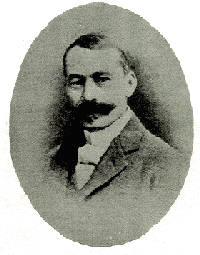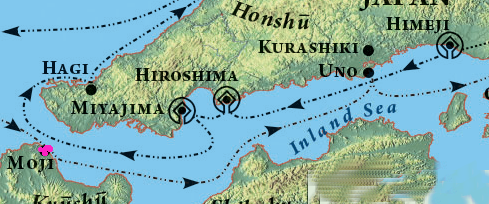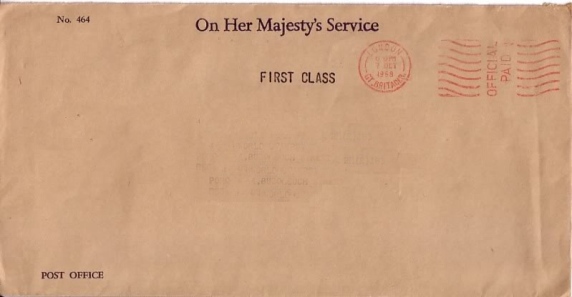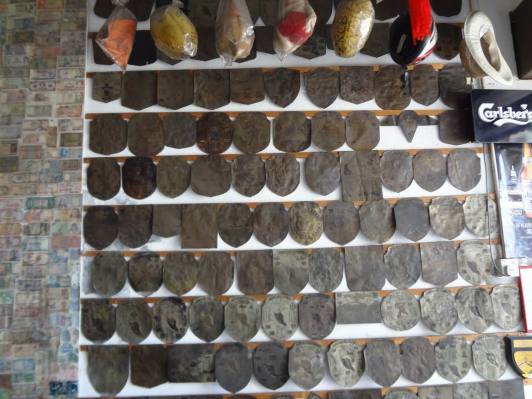
Uniform button from a BISNC uniform – we still wore the Company’s uniform even though the ship was sailing to Japan to be scrapped.

Of course, we wore our caps when required, mainly in port when we were duty officer. I did sail with captains that required the officer of the watch to wear his cap, even in the middle of the ocean.
After Penang our next port of call was to be Port Swettenham on the west coast of Malaysia. This port was the main port for the capital Kuala Lumpur, and the port’s name was changed in 1972, to Port Klang.
Today, Malaysia also has an administration and judicial centre called Putrajaya, which is also considered as a ‘capital’.
During the 1960’s we would contact Port Swettenham by radio via the code name ‘Klang Exchange’.
Before 1880 Klang was the capital of Selangor, but in 1880 the capital was moved to Kuala Lumpur, as a more strategic location.
Kuala Lumpur means “muddy confluence” as it is the location of where two rivers meet, and one of the rivers was named Klang River. During the opening of the tin mines near Kuala Lumpur in 1857, it was considered that KL was the furthest point up the Klang River that one could send supplies by boat.
In September 1882, Sir Frank Swettenham was appointed as the Resident of Selangor and he instigated a rail link from KL to Klang, because ships were becoming larger and they could not navigate the shallow waters of the Klang river, which caused problems for the export of tin.
Nineteen and a half miles of track was opened in 1886, and in 1890 the track was finally extended to Klang.
Sir Frank still had a problem, because as ships became larger the Klang river was now too shallow for these modern vessels to navigate up the river to even the town of Klang. It was decided that a new port was required at the mouth of the river, and when completed in 1901 the new port was called Port Swettenham.

Sir Frank Swettenham – March 1850 – June 1946 –
He married Vera Guthrie in 1939, she was forty nine when they were married.
She died in 1970.

Sir Frank in his younger days.
After a couple of days we sailed from Port Swettenham for Singapore – we sailed at 7.00 am, but we knew were were not due in Singapore until 6.00 am the following day – so we reduced speed and crept down the Malacca Straits.
The distance is about 225 nautical miles and we had 23 hours in which to make the journey, so even at our top speed of ten knots we’d be lucky to get there to meet our schedule. I think the Captain went at full speed and he allowed for the current slowing us down.
From Singapore we went sailed for – Port Swettenham – and arrived on a Saturday. Why does this stick in my mind you might ask – because I was roped in for a game of cricket.
If I was to write the sum of my football knowledge on the back of a stamp I’d have plenty of room for my knowledge of cricket. This game on Sunday went from 1030 am to 5.00 pm in the tropical heat of Malaysia.
We lost of course, and I cannot remember ever spending such a boring day. I’ve never liked ‘bat & ball’ even as a child.

Port Swettenham in the 1960’s
It must have been a holiday weekend because the following day I was again shanghaied in to playing football this time against a Ben Line ship (Ben Line was another British shipping company, who operated at that time from the UK to the Far East. I’m not sure if they are still in business.) but this time we won 3 – 1.
There was talk of a return match the following day, but as luck would have it, I was working!
Eventually we sailed for Hong Kong, which was at least a week’s sailing for us. There is always a silver lining because during the several days at sea between Port Swettenham and Hong Kong I managed to finish

in English of course.
We worked cargo in Hong Kong and made ready for our five-day run to Moji in southern Japan. We sailed at lunchtime on the 15th October 1967. A memorable day!
On the afternoon of the 16th October the weather had become quite wild because we were heading for the outer rim of typhoon Carla, which was later designated as Super Typhoon Carla, a category five typhoon, with wind speeds of 157 mph (252 km/h).

I found this on the internet of Typhoon Carla
Later we heard that this typhoon dumped 47.8 inches of rain in 24 hours in the Philippines, and the following day 108.2 inches on Taiwan in 48 hours, Oct 17 – 19th, killing 250 people and leaving 30 missing.

I managed to get a few pictures before the light faded. At that time my camera was a pure point and click with little refinements. We were about to meet the typhoon.

Pundua was old, and we could feel every shudder as she was struck by another wave.

The light was fading

The waves appeared to be getting larger . . .
By the evening the sea was very rough and we were shipping water over the fore deck and pitching and rolling at the same time. (known as corkscrewing).
The following day (17th October) I was on the 8 to 12 watch and so reported to the bridge.
I just wore uniform shorts and shirt, and flip flops, because wearing shoes seemed pointless with all the water around.
I entered the bridge via the inside staircase and stepped into ankle deep water on the deck of the enclosed part of the bridge. Visibility was down to less than three hundred yards, and the clouds seemed to blend with the ocean.
The wave height was estimated at about 30 feet (9 mtrs) and getting worse, and the wind about 45 mph (72 km / hr) whipped up spray from the crest of the waves, which didn’t help with visibility.
All we knew was that we were not making any headway through the water. We only had a vague idea of our location because we couldn’t see the sun and our ancient radar system had died, so we didn’t have any idea as to how close or how far we were from land
The waves and wind smashed our navigation lights, and the hatch cover on number one hatch, which was slowly being blown to pieces. We had heavy wire ropes on the forecastle, which were used as mooring lines, but these had been washed down on to the main fore deck so powerful were the waves.
Wooden covers off the aft hatch, near the crew’s quarters, had been smashed by the waves, but there wasn’t anything that we could do to secure the damage, it was too dangerous. I jammed myself in the corner of the bridge to stay upright.
Our captain sat in his tall chair looking out ahead – he’d been there all night.
I checked the chart and saw that there was a note attached giving our estimated position that was to be used if the radio operator had to send out an SOS due to our sinking and abandoning ship. A comforting thought as I added my comments of the weather in to the log book.
At 10.00 am on the 17th we had to turn out and secure the steering gear down aft. The strain on the steering gear, as we tried to keep the Pundua’s head in to the waves, caused a huge strain on the rudder (the system was manual steering, we didn’t have auto pilot), so we posted a man down in the steering area to warn us of any further problems with the system.
Every four hours we had to tighten very large nuts, which were part of the steering gear and due to the constant movement, started to come loose.
At noon I was relieved and went below – my cabin was a shamble, due to the constant violent movement of the ship everything was either broken or scattered, and of course everything was soaking wet. With the driving rain and the constant battering by the waves none of our cabins stood a chance of being waterproof. My cabin was one deck above the main deck.
There was little chance of sleep during off duty hours.
At 8.00 pm I was back on the bridge for my watch – the weather had got worse. The waves were estimated at 50 feet high (15.2 mtrs) & the wind was over 70 mph (113 km/h), in fact the wind was so strong we were unable to estimate the speed over 70 mph. Remember we were supposed to be on the rim of the typhoon.
Staggering down aft to check the steering gear was a life-threatening exercise.
The storm never let up for the next day and a half and during the night of the 18/19th October the storm began to ease.
We hadn’t been able to fix our position in three days, because of the lack of sun & stars, and we only had an estimated position (more of a gut feel).
At 6.30 am on the 19th October we saw land about five miles away! The problem was that we couldn’t identify the land, but we managed to turn around and headed back out to sea as the land might be China, Formosa (now Taiwan), or anywhere, because getting too close to unknown land would be dangerous because we didn’t know which chart to use.
At 8.00 am when I took over the watch the waves had dropped to about 25 feet and the wind to about 30 mph, the movement felt quite ‘pleasant’, compared to the previous day.
Later we were able to identify the land that we’d seen and we worked it out that to be in the position we were to see the land, we’d crossed rocks and a reef and recrossed the same reef and rocks when we turned to steam away from the land. One might say that the devil takes care of his own . . .
Later in the day we managed to get a shot at the sun and to work out our position. We were only 200 miles away from our position of three days earlier. We should have been 700 miles closer to Japan, but we’d been blown (pushed?), and failed to make any headway. We were 500 miles from our scheduled position.
The voyage from Hong Kong to Moji, at our speed, would have taken us five days, it had already been six days since leaving Hong Kong, and we had an estimated further four days to go.
We joked about our report to head office, Pundua five days late on a five day voyage.
On the 26th October we arrived in Moji which is at the southern entrance to the Inland Sea of Japan, the entrance is via the Kanmon Straits. See the map below.

The pink do marks Moji, but today is appears that the town has been swallowed up by surrounding towns, and on later maps is hard to find.
Today you can cross the Straits via ferry, or drive across the bridge or use the tunnel, which can be via train, car or even walk at its narrowest point.
As soon as we docked the agent came aboard – our favourite person if he has mail, but the most hated if he is empty handed.
I received mail from Maureen & my parents, and while sitting quietly reading (we were waiting for the labour to arrive to unload the cargo) my cabin door burst open and my steward dashed in holding letter in his hand and said to me –
‘Sahib, Sahib, you have a letter from your Queen!’
A letter addressed to me had been mixed with the Captain’s official letters, and the steward had been told to take this letter to me. Being an official looking letter, it managed to confuse my Goanese steward.

I copied the above from the internet to give you an idea why my steward was confused.
The real letter was addressed to me c/o the Company, and it was from the British Admiralty.
When I left Conway to go to sea I joined the RNR (Royal Navy Reserves), but as most of my sea time had been out East and around Australia, I had not reported for any training in the UK. When I was on leave I was not keen to sacrifice my leave, not even for Queen and Country.
Little did I know that I could have had my leave and still attended training with the Royal Navy.
The Company would have released me for the required training time & I’d still be on full pay, that’s how ignorant I was at eighteen, because I was never told of the ‘system’.
People assumed that cadets would be aware of the system. Well I wasn’t aware, and they were now after me for not completing any training in the last five years.
After some thought I decided to resign from the RNR, my resignation was accepted, and the clerks in the Admiralty were very happy, because this helped to keep their files in order.

The Company flag & distinctive black funnel with two white bands.

The above is a photograph of the first Pundua to join the fleet – launched in 1888 and broken up in 1920.
She was 3305 gt – besides being a passenger ship, operating between Colombo (Ceylon) to Tuticorin (southern India) she was used as a troop ship during various wars.
She carried troops during the Boer war, other troops to Shan-Hai-Khwan during the Boxer uprising in China, and from India, the Meeerut Regiment, which was an Indian regiment, to France in WW1.






























